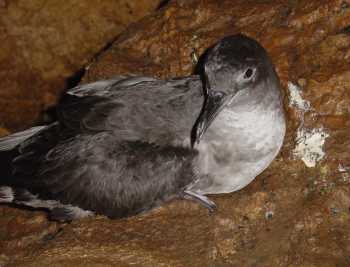The Balearic Shearwater Puffinus mauretanicus, endemic to Spanish islands in the Mediterranean Sea (click here), has been categorized as Critically Endangered by BirdLife International. The species has also been identified as a potential candidate for inclusion within the Albatross and Petrel Agreement, because of the risks it continues to face at sea from fisheries and on land from introduced predators (click here).

The Population Ecology Group is a Spanish research team established in 1999, which groups researchers from the fields of biology, marine sciences, physics and veterinary science. Projects deal with the biology of threatened populations in marine Mediterranean habitats, with an emphasis on the relationships between seabirds as marine predators and fisheries operating in the western Mediterranean. The group is headed by Dr Daniel Oro and forms part of the Mediterranean Institute for Advanced Studies (IMEDEA), a research centre jointly governed by the Consejo Superior de Investigaciones Científicas and the University of the Balearic Islands.
A list of publications up to 2009 on the Balearic Shearwater by IMEDEA's Population Ecology Group may be found at http://www.imedea.uib.es/natural/goi/seabirds/eng/2/21.html.
At the most recent meeting of ACAP's Advisory Committee, held in Argentina in April 2010, France advised that in consultation with Spain it would give consideration jointly to proposing that the Balearic Shearwater be added to Annex 1 of the Agreement. The Advisory Committee welcomed this advice and looked forward to considering the documentation, noting that a Species Assessment had been drafted by the Secretariat in 2008 (click here for the meeting's report).
For a list of Action Plans for the Balearic Shearwater go to:
Cooper, J. 2010. A brief review of the conservation status of shearwaters Calonectris and Puffinus. ACAP AC5 Inf 15.
For three papers published in 2010 on Balearic Shearwaters see:
Andrade, J. & Ramirez, I. 2010. Monitoring Balearic Shearwaters on the Portugese Atlantic coast. Seabird Group Newsletter 114: 9-13.
Bartumeus, F., Giuggioli, L., Louzao, M., Bretagnolle, V., Oro, D. & Levin, S.A. 2010. Fishery discards impact on seabird movement patterns at regional scales. Current Biology 20: 215-222. http://www.cebc.cnrs.fr/publipdf/2010/2010_BCB20.pdf.
Käkelä, R., Käkelä, A., Martínez-Abraín, A , Sarzo, B., Louzao, M., Gerique, C., Villuendas, E., Strandberg, U., Furness, R.W. & Oro, D. 2010. Fatty acid signature analysis confirms foraging resources of a globally endangered Mediterranean seabird species: calibration test and application to the wild. Marine Ecology Progress Series 398: 245-258. http://www.int-res.com/abstracts/meps/v398/p245-258/.
Click here for a recent ACAP news item on the closely related Yelkouan Shearwater P. yelkouan, also endemic to the Mediterranean and similarly identified by ACAP as a potential candidate for listing within the Agreement.
With thanks to Daniel Oro for information
John Cooper, ACAP Information Officer, 13 November 2010, updated 24 December 2010

 English
English  Français
Français  Español
Español